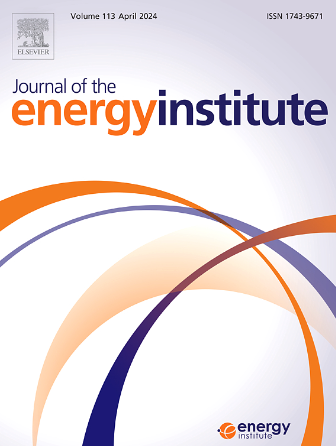Thermodynamic modeling of entrained-flow gasification of solid fuels covering biomass and coal categories: Model simplification, validation, and application
IF 5.6
2区 工程技术
Q2 ENERGY & FUELS
引用次数: 0
Abstract
In this study, a simplified stoichiometric equilibrium model dedicated to modeling entrained-flow gasification systems was proposed. The model was then validated by comparing its predicted results with experimental data obtained from lab-scale drop tube furnace (DTF) tests conducted in this study, a pilot- and industrial-scale entrained-flow coal gasifiers documented in literature. Finally, the model was used to investigate the gasification performance of 29 solid fuels belonging to biomass and coal categories. Model validation demonstrated that the applicable temperatures for the simplified model must exceed 1200 °C for coal and 1300 °C for biomass. At this temperature, a good consistency was observed between the predicted and the experimental gas compositions, regardless of the gasifier scales. The modeling investigation for 29 solid fuels based on the simplified model revealed that under high-temperature entrained-flow gasification conditions, the CO2 and H2O yields produced from biomass fuels were much higher than those from coals. Consequently, biomass fuels demonstrated poor performance indicators in terms of a reduced cold gas efficiency (CGE), elevated specific fuel consumption (SFC), and increased specific oxygen consumption (SOC) compared to coals. The addition of steam positively influenced gas quality for high-rank coals; however, it appeared economically disadvantageous for law-rank coal and biomass as it led to a reduction in CGE and an increase in SFC and SOC. The results of this work are expected to provide valuable insights into the design and optimal operation of entrained-flow gasification systems for various fuel categories.
涵盖生物质和煤类固体燃料夹带流气化的热力学建模:模型简化、验证和应用
在这项研究中,提出了一个简化的化学计量平衡模型,专门用于模拟夹带流气化系统。然后,通过将其预测结果与本研究中进行的实验室规模滴管炉(DTF)测试获得的实验数据进行比较,验证了该模型,实验数据来自文献中记录的中试规模和工业规模的夹带流煤气炉。最后,利用该模型对29种固体燃料(生物质和煤)的气化性能进行了研究。模型验证表明,简化模型的适用温度对于煤必须超过1200°C,对于生物质必须超过1300°C。在此温度下,无论气化炉规模如何,预测和实验气体成分之间都观察到良好的一致性。基于简化模型对29种固体燃料的建模研究表明,在高温携流气化条件下,生物质燃料产生的CO2和H2O的产率远高于煤。因此,与煤炭相比,生物质燃料在冷气效率(CGE)降低、比燃料消耗(SFC)升高和比氧消耗(SOC)增加方面表现出较差的性能指标。蒸汽的加入对高阶煤的煤气质量有积极影响;然而,对于普通煤和生物质来说,这在经济上是不利的,因为它导致了CGE的降低和SFC和SOC的增加。这项工作的结果有望为各种燃料类别的夹带流气化系统的设计和优化操作提供有价值的见解。
本文章由计算机程序翻译,如有差异,请以英文原文为准。
求助全文
约1分钟内获得全文
求助全文
来源期刊

Journal of The Energy Institute
工程技术-能源与燃料
CiteScore
10.60
自引率
5.30%
发文量
166
审稿时长
16 days
期刊介绍:
The Journal of the Energy Institute provides peer reviewed coverage of original high quality research on energy, engineering and technology.The coverage is broad and the main areas of interest include:
Combustion engineering and associated technologies; process heating; power generation; engines and propulsion; emissions and environmental pollution control; clean coal technologies; carbon abatement technologies
Emissions and environmental pollution control; safety and hazards;
Clean coal technologies; carbon abatement technologies, including carbon capture and storage, CCS;
Petroleum engineering and fuel quality, including storage and transport
Alternative energy sources; biomass utilisation and biomass conversion technologies; energy from waste, incineration and recycling
Energy conversion, energy recovery and energy efficiency; space heating, fuel cells, heat pumps and cooling systems
Energy storage
The journal''s coverage reflects changes in energy technology that result from the transition to more efficient energy production and end use together with reduced carbon emission.
 求助内容:
求助内容: 应助结果提醒方式:
应助结果提醒方式:


